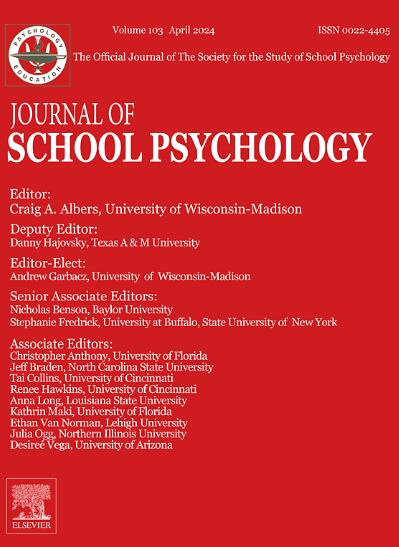儿童和青少年社会支持量表:评估来自五个来源的四种感知支持
IF 4.1
1区 心理学
Q1 PSYCHOLOGY, SOCIAL
引用次数: 0
摘要
儿童和青少年社会支持量表(CASSS)是儿童和青少年最常用的感知社会支持的措施之一。支持代表各种支持来源的子量表的心理测量特性是公认的。然而,对于表示支持来源中的各种支持类型的子量表,可用的支持较少。当前研究的目的是调查CASSS的经验衍生维度与其多维理论框架的一致程度,该框架由四种类型的感知支持(即情感,信息,评价和工具)组成,这些支持来自五个支持来源(即父母,老师,同学,亲密朋友和学校的人),不同样本的七年级和八年级学生(N = 901)。对四个验证性因子模型进行了检验和比较。结果表明,包含以下一个或多个结构的模型具有良好的拟合性:来源类型(例如,父母情感支持),来源(例如,父母支持包括所有类型)和整体社会支持。这些结构在不同的社会经济资源中存在强/标量不变性,但在不同的性别中,这些结构只存在弱/度量不变性。本研究的证据支持CASSS的结构保真度作为衡量从重要来源感知的社会支持类型的指标,并建议在比较CASSS分数时要谨慎。意义声明:本研究的结果支持使用CASSS来测量中学生不同来源的感知社会支持类型。然而,在比较不同性别的分数时,谨慎是必要的,因为结果表明CASSS分数在中学男生和女生之间可能不具有可比性。本文章由计算机程序翻译,如有差异,请以英文原文为准。
The child and adolescent social support scale: Assessing four types of perceived support from five sources
The Child and Adolescent Social Support Scale (CASSS) is one of the most commonly used measures of perceived social support with children and adolescents. The psychometric properties supporting the subscales representing the various sources of support are well-established. However, less support is available for the subscales representing the various types of support within support sources. The purpose of the current study was to investigate the degree to which the empirically derived dimensions of the CASSS align with its multidimensional theoretical framework consisting of four types of perceived support (i.e., emotional, informational, appraisal, and instrumental) from each of five sources of support (i.e., parent, teacher, classmate, close friend, and people at school) with a diverse sample of 7th and 8th grade students (N = 901). Four confirmatory factor models were tested and compared. Results indicated good fit for models that included one or more of the following structures: source by type (e.g., parent emotional support), source (e.g., parent support including all types), and overall social support. Strong/scalar invariance was found for these structures across socioeconomic resources, but only weak/metric invariance was found for these structures across gender. Evidence from this study supports the structural fidelity of the CASSS as a measure of the type of social support perceived from important sources and suggests caution in comparing CASSS scores across gender.
Significance Statement: Results of the current study support the use of the CASSS to measure type of perceived social support from different sources in middle school students. However, caution is warranted when comparing scores across gender, given results indicating that CASSS scores may not be comparable across middle school boys and girls.
求助全文
通过发布文献求助,成功后即可免费获取论文全文。
去求助
来源期刊

Journal of School Psychology
PSYCHOLOGY, EDUCATIONAL-
CiteScore
6.70
自引率
8.00%
发文量
71
期刊介绍:
The Journal of School Psychology publishes original empirical articles and critical reviews of the literature on research and practices relevant to psychological and behavioral processes in school settings. JSP presents research on intervention mechanisms and approaches; schooling effects on the development of social, cognitive, mental-health, and achievement-related outcomes; assessment; and consultation. Submissions from a variety of disciplines are encouraged. All manuscripts are read by the Editor and one or more editorial consultants with the intent of providing appropriate and constructive written reviews.
 求助内容:
求助内容: 应助结果提醒方式:
应助结果提醒方式:


